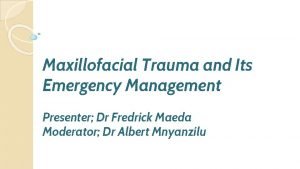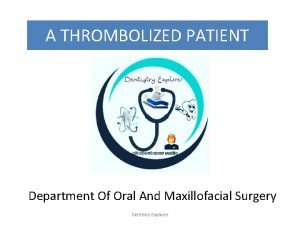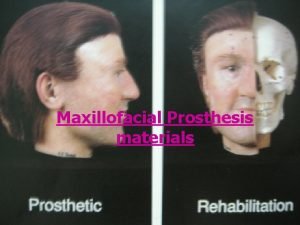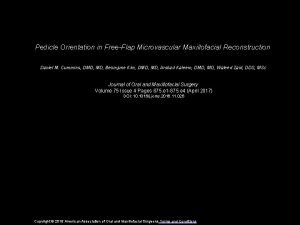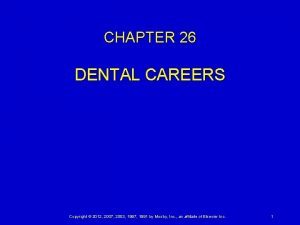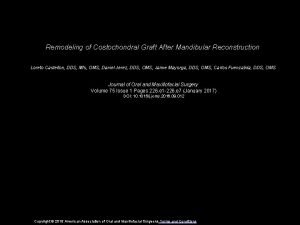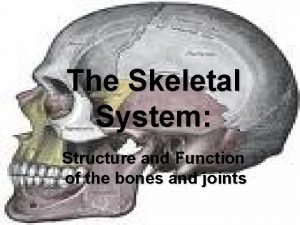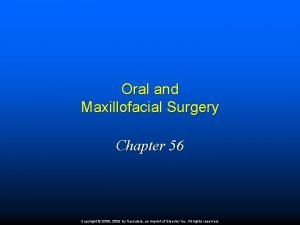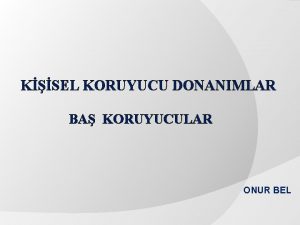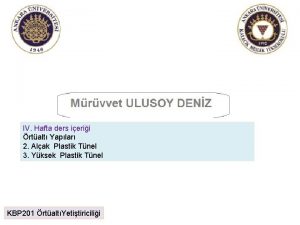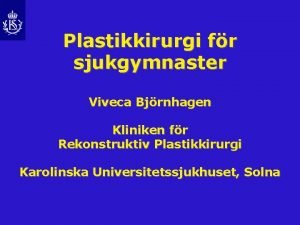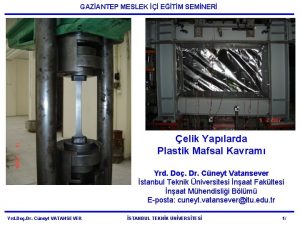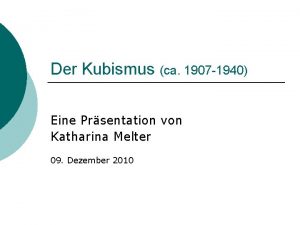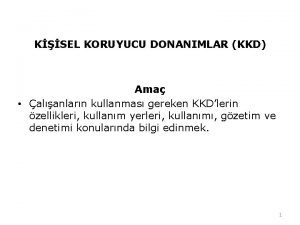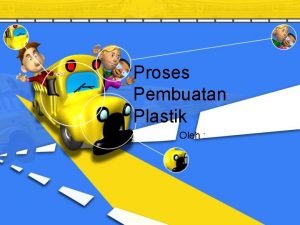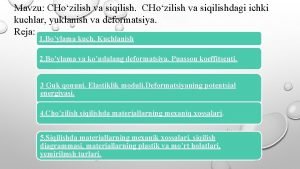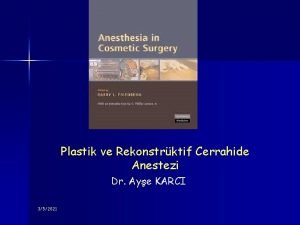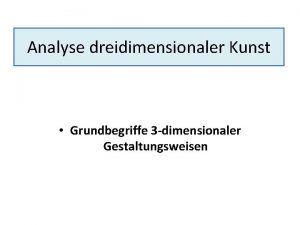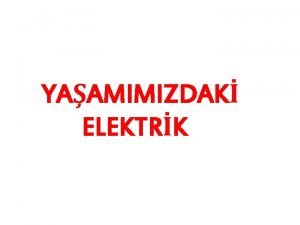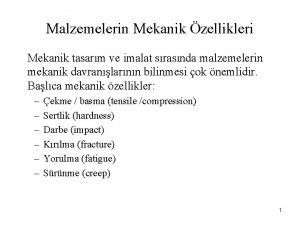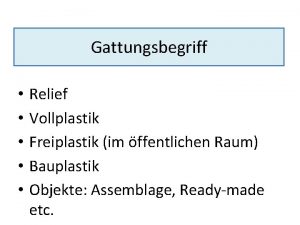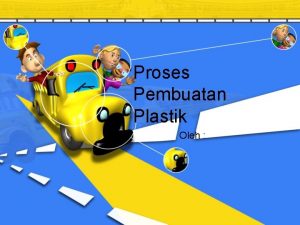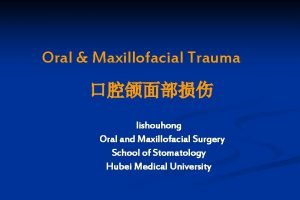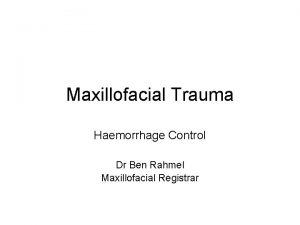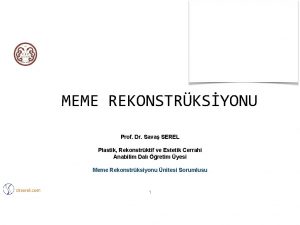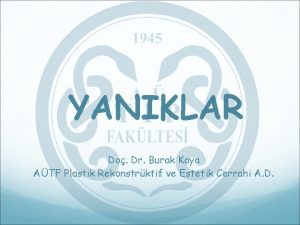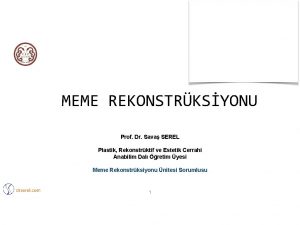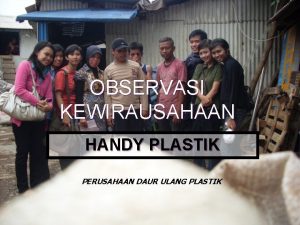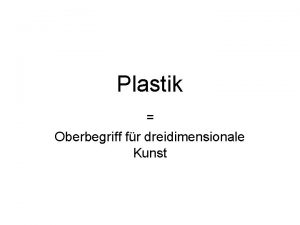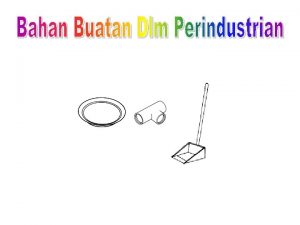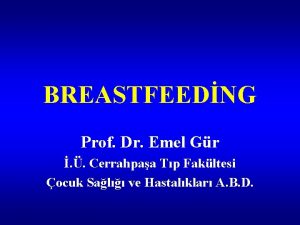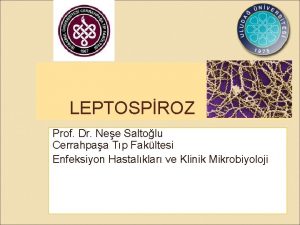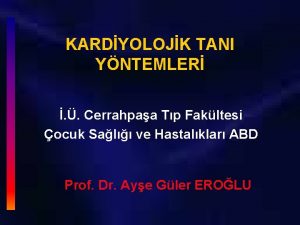MAXILLOFACIAL TRAUMA Cerrahpaa Tp Fakltesi Plastik Rekonstrktif ve



































- Slides: 35

MAXILLOFACIAL TRAUMA İ. Ü. Cerrahpaşa Tıp Fakültesi Plastik, Rekonstrüktif ve Estetik Cerrahi Anabilim Dalı Dr. Hakan Arslan

Maxillofacial trauma • Soft tissue injuries • Soft tissue with bone fractures • Bone fractures

Etiology • Traffic accidents • Assault • Sport injuries • Domestic accidents • Industrial accidents • Gunshot wounds

Primary survey Ⓐ Airway maintenance with cervical spine control Ⓑ Breathing and ventilation Ⓒ Circulation with hemorrhage control Ⓓ Disability assessment of neurological status Ⓔ Exposure and complete examination of the patient 8

Priority in Maxillofacial injuries • Airway maintenance – clearence of blood, teeth or vomit from oropharynx – Aspiration – Tracheostomy

Priority in Maxillofacial injuries • Hemorrhage Control – Direct pressure – Ligation of vessels (A. Facialis, A. Temporalis Superficialis, A. Angularis, A. Carotis Externa) – Antero-posterior nasal tamponade – Embolization of vessel

Priority in Maxillofacial injuries • Assessment of concomitant injuries (cervical, cranial, thoracic, abdominal injuries) • Assessment of facial trauma

Tracheostomy Indications in Maxillifacial Injuries • Panfacial fracture • multi fragment mandibular fracture associated with significant edema of oral floor and neck • maxillofacial trauma requires intermaxillary fixation • concomitant thoracic and intracranial injury

Tracheostomy Indications in Maxillifacial Injuries • Head and Neck burn injury • Occlusion of larynx and hypopharynx • Possibility of long duration of airway problem after operation

Clinical Findings • soft tissue injury • crepitus, pain and mobility of underlying bone part • paresthesia or anesthesia • paralysis of motor nerve • Malocclusion • ocular injury – Diplopia and/or decreased visual acuity • facial asymetry or deformity • intra oral laceration • Nasopharengeal hemorrhage

Soft tissue Injuries superficial/deep simple/complex special zones eyebrow eyelids lips nose special tissue facial nerve facial muscles

12

Facial Fractures nose orbital (floor-roof) zygoma maxilla mandibula

Orbital Fractures – Orbital floor (blow-out) fractures • Pure ( intact orbital rim) • Inpure (with orbital rim fracture) – Orbital floor fracture without blow out • Linear fractures • with maxillary fractures • orbital floor fracture with only zygomatic part

Orbital Floor (Blow-out) Fracture • Clinical findings – Periorbital hemorrhage- ecchymosis and subconjunctival hemorrhage – İnfraorbital nerve damage- paresthesia, anesthesia – Diplopia – Enophtalmos – Positive Forced duction test (+) – CT scan confirmation of fracture and herniation of orbital contents into maxillary sinus

Superior Orbital Fissure Syndrome ve Orbital Apex Syndrome • N. Occulomotorus (CN III) paralysis (levator, superior rectus, medial rectus, inferior rectus ve inferior oblique muscle) • N. Trochlearis (CN IV) paralysis (superior oblique muscle) • N. Abducens (CN VI) paralysis (lateral rectus muscle) • Trigeminal nerve (CN V) ophtalmic branch- anesthesia (upper eyelid, eyebrow, upper nose area, ipsilateral frontal zone) • N opticus involvement ----- Orbital Apex Syndrome

Nasoethmoidoorbital Fracture • clinical findings – Telecantus – decreased dorsal nasal projection – rhinorrhea

Tip 1 Tip 3 Tip 2 Classification of Nasoethmoidoorbit al Fracture

Maxillary Fractures Le Fort Le. Fort I fracture is a horizontal maxillary fracture across the inferior aspect of the maxilla and separates the alveolar process containing the maxillary teeth and hard palate from the rest of the maxilla. Le. Fort II fracture is a pyramidal fracture starting at the nasal bone and extending through the ethmoid and lacrimal bones; downward through the zygomaticomaxillary suture; continuing posteriorly and laterally through the maxilla, below the zygoma; and into the pterygoid plates. Le. Fort III fracture or craniofacial dysjunction is a separation of all of the facial bones from the cranial base with simultaneous fracture of the zygoma, maxilla, and nasal bones.

Maxillary Fractures – Periorbital hemorrhage – Nasopharengeal hemorrhage – facial edema – intaoral lacerations – Maloclussion – Facial elongation – Maxillary retrution – Anterior open bite – Maxillary dental arch mobility – Rhinorrhea (Le Fort II ve III % 250

Zygoma Fractures Classification 6 type usually tripod fracture isolated zygoma archus fracture usually concomitant with orbital and maxillary fracture

Tripod Fracture



Zygoma Fracture Clinical findings malar depression and flattening subconjunctival hemorrhage periorbital eccyhmosis- edema no maloclussion paresthesia-anesthesia (inferior orbital nerve)

Mandibula Fractures Classification anatomic region (most common) condyle ve subcondylar fracture kırık hattının yanında diş olup olmaması dişlerin olup olmaması (edontolous)

Body 30 -40 % Angle 25 -30 % Condyle 15 -17 % Symphysis 7 -15 % Ramus 3 -9 % Alveolar 2 -4 % Coronoid Process 1 -2 %

Mandibular Fractures In almost every mandibular fracture Pain during opening-closing the mouth Malocclusion

Facial Fractures in Children • Features – older than 5 years old – the most common subcondylar fracture – Pediatric bones are cancellous and soft, may displaced without fracture – Bone healing is faster after fracture. reduction of bones is quite difficult after 1 week.

Facial Fractures in Children Little deformities can be corrected spontanously due to the adaptive potential of the alveolar bone and the permanent teeth eruption due to the mixed dentition, open reduction and rigid fixation should be done carefully. intermaxillary fixation is quite difficult because of the superficial localization of the teeth roots Paranazal sinüsler küçüktür

Treatment open reduction- internal fixation mini plates- screws cerkilage wires Basic principles fixate butresses establish occlusion normal facial contour maintaine globe position




TEŞEKKÜR EDERİM
 Emergency management of maxillofacial trauma
Emergency management of maxillofacial trauma Bahan yang terdiri atas kandungan bahan yang lentur
Bahan yang terdiri atas kandungan bahan yang lentur American academy of oral and maxillofacial radiology
American academy of oral and maxillofacial radiology Chapter 56 oral and maxillofacial surgery
Chapter 56 oral and maxillofacial surgery Materials used in maxillofacial prosthesis
Materials used in maxillofacial prosthesis Maxillofacial
Maxillofacial Abcsses
Abcsses Chapter 26 oral and maxillofacial surgery
Chapter 26 oral and maxillofacial surgery Maxillofacial
Maxillofacial Shape of bone
Shape of bone Chapter 56 oral and maxillofacial surgery
Chapter 56 oral and maxillofacial surgery Sistem produksi kerajinan dengan inspirasi budaya lokal
Sistem produksi kerajinan dengan inspirasi budaya lokal Yüksek düzeyde yalıtkan plastik baretler
Yüksek düzeyde yalıtkan plastik baretler Ketika anda memeras ujung kantong plastik
Ketika anda memeras ujung kantong plastik Plastik kaşık
Plastik kaşık Plastik sanatlar nedir edebiyat
Plastik sanatlar nedir edebiyat Alçak plastik tünel
Alçak plastik tünel Gambar kubus dengan ukuran 5 cm
Gambar kubus dengan ukuran 5 cm Augmentationsplastik
Augmentationsplastik Gerilme
Gerilme Picasso analytischer kubismus
Picasso analytischer kubismus Contoh contoh iks
Contoh contoh iks Yüksek düzeyde yalıtkan plastik baretler
Yüksek düzeyde yalıtkan plastik baretler Proses pengolahan plastik
Proses pengolahan plastik Mexanik kuchlanish formulasi
Mexanik kuchlanish formulasi Kartu plastik
Kartu plastik Plastik cerrahide anestezi
Plastik cerrahide anestezi Ansichtigkeit plastik
Ansichtigkeit plastik Sifat bahan jas hujan
Sifat bahan jas hujan Pengemasan plastik
Pengemasan plastik Tarakla elektriklenme deneyi
Tarakla elektriklenme deneyi Elastik şekil değişimi
Elastik şekil değişimi Reliefarten
Reliefarten Mekanisme transaksi kartu kredit dengan melibatkan acquirer
Mekanisme transaksi kartu kredit dengan melibatkan acquirer Ergitmesiz kaynak türleri
Ergitmesiz kaynak türleri Halimbawa ng salitang pagpapalit
Halimbawa ng salitang pagpapalit
